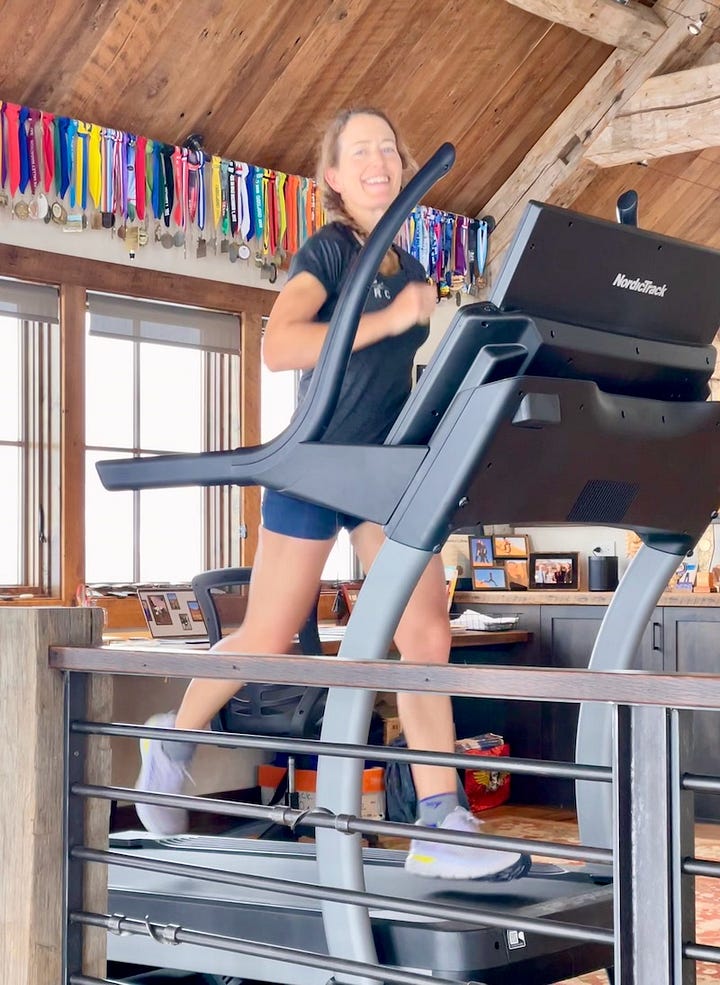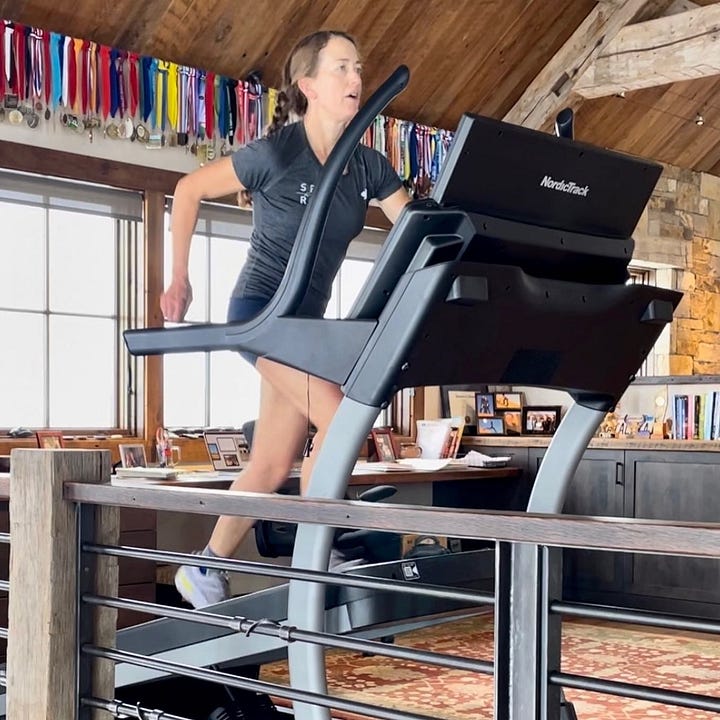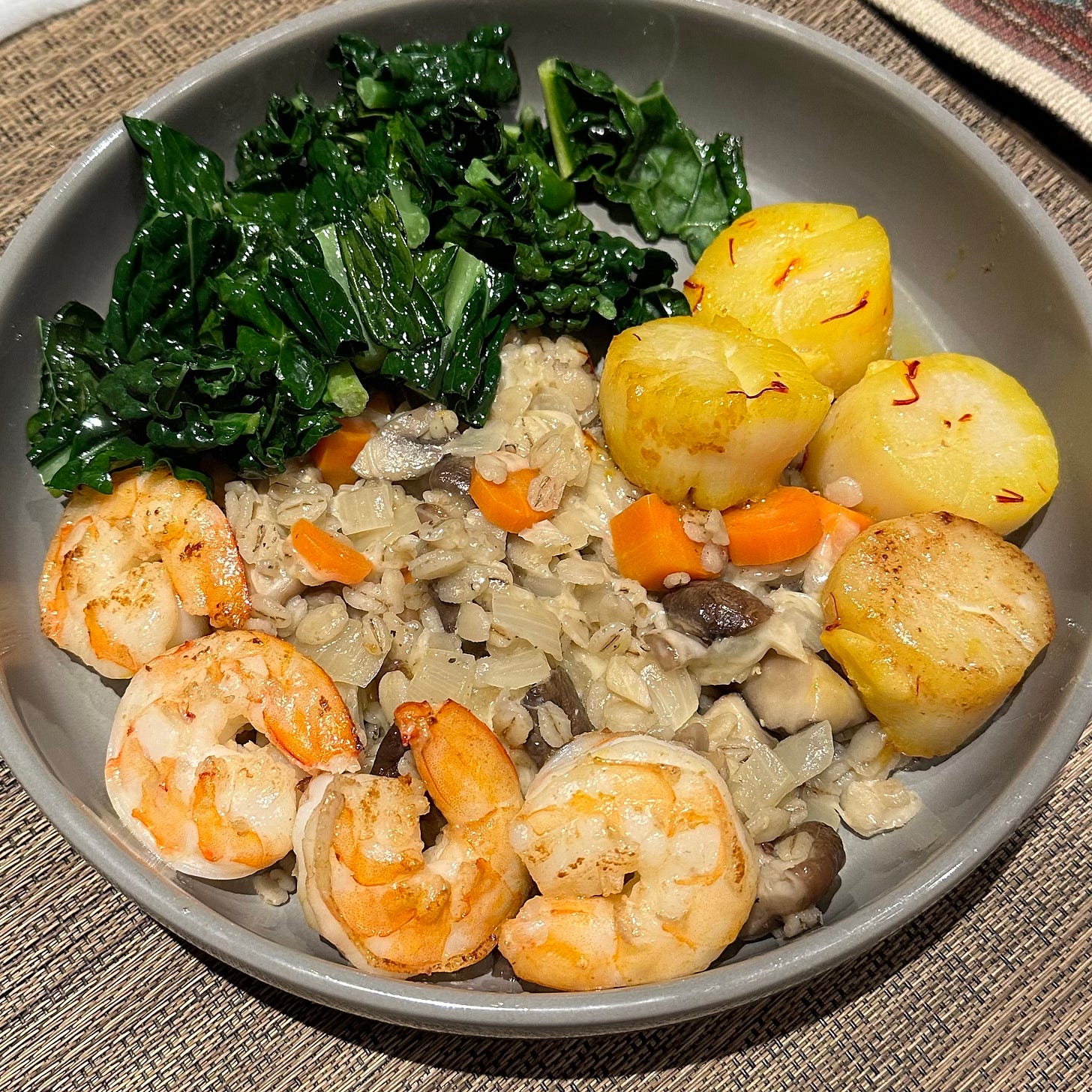How to Get Your Run Done
Plus sensitive, sensible advice on nutrition & weight loss for runners
Welcome to another hump-day edition. Later today, I host the monthly online meetup for paid subscribers, where we talk about running, wellness, and generally get to know each other. Today’s Zoom features a Q&A with a special guest. If you’d like to have an invitation to the monthly meetup and also receive occasional bonus posts, please consider upgrading your subscription to the supporter level.
Let’s talk about motivation—that is, the reason, desire, and drive to do what you set out to do and to finish something you started.
I normally don’t need motivation to run. I’ve been running for so long that it’s part of daily life, like making the bed and going to the grocery store. During the weekend, I plan and schedule my training runs for the coming week and just do them, like Nike’s catchphrase. Motivation might wane mid-ultra or toward the end of a long run, but that’s to be expected, and I’ve experienced that dip in energy and determination enough times to feel confident it’ll pass. Everyday training runs lasting around 45 to 90 minutes, by contrast, usually are a pleasure rather than a problem to execute.
Until last Thursday.
I had one of those days that’s probably familiar to many runners who work from home: You dress to go running, but then you sit at your desk as the hours slip past. You experience an unsettled feeling of being unstructured and uncertain, neither having done your run nor showered and dressed to transition to work mode. Should you keep working, or pause and run now before lunch, or eat lunch and run in the early afternoon? Or should you skip the planned run, take a shower, and put on real clothes for the remainder of the day? Nothing feels good or right. You just know for sure that if 4:30 rolls around and you’re still in your running clothes but haven’t run, you’ll feel like shit.
For this day, I had scheduled a key run—a speed workout on my treadmill. Blowing it off would create a three-day stretch of no running during a week when I’m supposed to be peak training for an ultra on February 3.
I have a self-imposed rule of taking no more than one day off in between runs unless I’m sick or recovering from a depleting race. This rule has fostered consistent running four to six days a week over three decades. I needed to run Thursday because I had deliberately taken off Wednesday as a rest day. And I probably couldn’t run Friday because I was scheduled to substitute teach all day and then go to a CrossFit class.
But I had zero desire to move my body on that treadmill. I wanted instead to read articles and tinker with a scene I’ve been writing. I wanted to do a unit of Babbel for Spanish study and plan a trip to a June wedding. I even wanted to do laundry and my 2023 P&L statement for our taxes. I wanted to do anything but get on that treadmill and push myself for an hour.
My Garmin said my Training Readiness was “High” thanks to the prior day’s rest. I had slept 7.5 hours. I felt well-fueled from a healthy breakfast (two eggs, half a baked sweet potato, milk) and a mid-morning snack (apple and a scoop of peanut butter). I wasn’t sick. I wasn’t injured. I wasn’t experiencing hormonal swings. I was just utterly unmotivated.
What is my problem? Where is my motivation? Why can’t I “just do it”?
I’ll share what I concluded, along with some motivation hacks, with the hope it helps you regain motivation when you’re feeling the deep blahs that I experienced. It starts with identifying “what’s my problem?”—identifying what’s holding me back.
Maybe the problem is the workout. I wanted a high-quality, high-intensity workout as scheduled, because I know the benefits that come from a weekly speed session. Even if I don’t need to run very fast for ultras, I need to run fast occasionally (ideally, at least once/week) to boost cardiovascular fitness and combat the ultra-shuffle with quick turnover and a full stride. But running fast on a treadmill feels so stressful. It’s not like the track workouts I used to do with a group, when camaraderie and ego enabled me to run fast by imagining a rope connecting me to the runner just ahead and feeling pulled along by her stride. It’s also not as manageable as a speed session on our local bike path, where I can look ahead in the distance and think, run hard to that point. A treadmill is a hamster wheel in stifling indoor air. But Thursday was bitterly cold and windy with a snowstorm, so the “dreadmill” was my best option.
Maybe the problem is my watch (or rather, my emotional reaction to it). I can feel so discouraged looking at my watch. My “fast” pace now, when I try to run close to maximum heart rate, was my recovery pace 10-plus years ago. I can barely run one mile at what used to be my marathon goal pace for 26 miles. Last Thursday, I didn’t want to face those numbers, which entails facing my aging.
Maybe the problem isn’t really a problem but rather a positive distraction. I didn’t want to run in part because I was in a groove at my desk, feeling motivated and productive with some projects. That’s a good thing, right? Reframing the situation this way introduced some self-compassion.


How I finally got on the treadmill and did the damn thing
Ultimately, I ran a high-quality workout for an hour on the treadmill, totaling about 6.25 miles, which left me sweaty and satisfied. I had planned the following: a 10-minute warmup; 3 x 10-minute intervals that begin at tempo pace (“comfortably hard” or approximately an 8 out of 10 for rate of perceived exertion) and increase in the final minutes to closer to max effort, each followed by a 5-minute recovery jog. Then I’d spend the final five minutes of the hour practicing fast uphill hiking with the incline cranked up to 15% - 20%. (Notice I structure these intervals by time rather than mileage. Mentally I find it better to commit to a time block, regardless of what the mileage reading says.)
Here’s how it went, and the motivation hacks that helped:
Remind yourself why you’re doing this. I reminded myself of the myriad benefits of a run like this, including: the increased fitness, the post-run glow of sweaty satisfaction, the good unplugged thinking that germinates mid-run. I realized I would not regret running, but I would regret not running. (I once ran behind someone in a race whose T-shirt’s funny quote stuck with me: “‘I really regretted that run.’ — said no one ever.”) I told myself that when I’m trying to run harder and faster in my two upcoming races, I’ll be grateful for workouts like this one.
Imagine how you’d feel if you were injured. If you’ve had a run-stopping injury, you can probably recall how much you yearned to run then. I reflected on that feeling and felt grateful for the opportunity to run. I also thought of injured runners I know who are rehabbing now and felt glad I’m not in their shoes.
Queue up entertainment in your ears. I found a podcast I wanted to hear (NPR’s “Fresh Air” is always a reliable source for interesting interviews), and I listened to it for the first part, then switched to the “Happy Mix” on Spotify.
Start slowly and warm up. I let myself start at a really, really easy pace—a baby-step jog at 5mph (12 min/mile). Soon I grew impatient and shifted to 6mph (10 min/mile), which still felt easy. This level of ease made me think, “I can do this,” and, “I want to run faster soon.”
Lower the bar. I reminded myself, “Some is better than none”—maybe I wouldn’t run the whole workout, but I’d at least get started and try one of the intervals. I also took pressure off myself by thinking about running “faster” instead of “fast.” To me, “fast” means an unattainable pace that I used to run, so it sets me up for failure to plan to run “fast.” By contrast, thinking of “faster” is more flexible, achievable, and intuitive.
Go super easy on the recovery laps. I made the “easy” 5-minute recovery intervals truly easy. I let myself slowly jog and twice paused the treadmill to stop and drink water. The easy recovery interval stokes a feeling of readiness and desire to run fast(er) during the next speed interval.
Ignore the watch. I wear my Garmin so I can look at my workout data after the fact. But mid-run, I often find the pace and distance readings more discouraging than motivating. On the treadmill, I ignore the watch on my wrist, looking only at my treadmill’s time reading to check the elapsed time of the interval, and otherwise keep my eyes fixed on a spot on the wall, above the treadmill panel. This allows for running by perceived exertion—by feel—rather than by number.
Tweak the workout midway. I gave myself permission to modify the planned workout if I felt like it. After the second 10-minute interval, I felt bored and didn’t want to repeat it for a third. I chose instead to make the third interval a combo of speed and hills. I ran slower, but with strong effort, as I played with the treadmill’s incline from 3% to 6%.
When all else fails, harness strong negative emotions. Maybe you’re angry and frustrated with something related to work or a relationship. Maybe you’re secretly jealous and feeling competitive toward another runner who’s training harder than you. Give into those pissed-off or envious emotions and use them to fuel your workout as a way to blow off steam. I admit, when I scroll Instagram, I see posts by certain ultrarunning influencers who bug me because of their excessive posts bragging about their runs and races. I think to myself, “Ugh, she’s so annoying. But if she can do that for five hours, I definitely can do this for one hour.”
What gets you out the door (or on a treadmill) to run when you’d rather stay sedentary? What gets you started on something you know is good for you but you’re dreading? Please share your motivation strategies or tips in the comments below.

A sensitive subject
I’ve been thinking about food (not just nutrition, but also our relationship to eating) and weight (not just the number on the scale, but also body composition) and want to share some New Year’s-oriented thoughts, advice, and recommended links. But I do this carefully, knowing that any talk about food and weight—especially among runners who are prone to desire to lose more, even if they have a healthy body size—can trigger psychological reactions that set up or reinforce an adversarial and overly controlling relationship with food. Ideally, food should be a source of energy, health, and satisfaction—along with joy and gratitude—and you shouldn’t overthink and overly monitor or restrict what you ingest.
So let me preface this by saying what I always told my clients whom I coached: Food is your fuel and your friend. My goal in talking about eating and weight is to help you love and nourish your body, to feel better running, and to encourage an easygoing, flexible, and positive relationship with mealtimes and snacking.
Let’s face it: This is the time of year when it’s common to feel a little (or maybe a lot) heavier. Many of us carry extra pounds following Thanksgiving through New Year’s due to food-centric holiday celebrations combined with the cold winter weather. If you put on weight during December, you’re in good company.
It’s also the time of year when many runners have goal races—such as a summer ultra or a fall marathon—several months away, and we’re planning our training to build up to that “A” race.
Some of you probably know objectively that you would run better and feel better—and by “better” I mean more efficiently, comfortably, lighter on your feet, and less out of breath—if you lost some of the weight you gained. If you’re not one of those people, and you feel great at your current size, hooray! You probably don’t need to read this.
But if you reasonably conclude that as an athlete you would feel and do better if you were lighter or converted more fat to muscle (listen to the podcast linked below for guidance on what’s “reasonable”), and if you have goal races later in the year, then my message to you is this: It’s advantageous to adjust your nutrition and start changing your body composition sooner rather than later. The reasons are many:
Any adjustment in nutrition with an aim to reduce weight or alter body composition should be gradual to be effective and long-lasting. Sudden or drastic changes likely will backfire by slowing the metabolism and compromising your energy level for training and health. Feeling deprived also sets up the adversarial relationship to food that you want to avoid.
The best time to modify and perhaps carefully limit some of your food intake is when you are early in a training cycle, with a less demanding training load. During this earlier phase, you can use strategies such as shifting your macronutrients to be lighter on carbs without compromising your training and energy levels significantly. Also, if you achieve a more desired size earlier in your training cycle, then it’ll make the weeks and months of running that follow feel better.
When you increase your training load (e.g. you increase the duration and sometimes also the intensity of your runs), it’s essential to fuel your body to satisfaction and increase your caloric intake. You’ll feel hungrier when you’re training hard, and you’ll benefit from increased carbs for fueling your runs. In other words, the worst time to limit energy intake is when you’re training at a higher level. During peak training, runners—especially ultrarunners—should take in plenty of calories mid-run to adapt their gut to mid-race fueling, and also take in plenty of carbs and protein post-run to refuel and repair.
A lot of runners make the mistake of trying to shed some pounds when they’re tapering in the two to three weeks pre-race. This is a bad idea—especially if it’s a long ultra in challenging conditions such as high altitude. It’s best to go into a race well fueled and well rested, and it’s much better to be a little heavy but feeling strong rather than lighter and feeling weak from calorie restriction. That’s one more reason to improve your nutrition, and adjust your weight if need be, early in your training rather than close to a race you care about.
I share all of the above with the hope it motivates you to approach any changes to your nutrition and body size in the most sensible, gradual, and long-range way possible. The first two links in the bulleted list below are good starting points. I also encourage you to consider hiring a credentialed nutritionist who works with endurance athletes.
Here are the links and recommendations that triggered my thinking this past week:
This podcast by Jason Koop interviewing nutritionist, coach, and champion ultrarunner Stephanie Howe is one of the most sensible and enlightening conversations I’ve heard on the topic of weight loss for ultrarunners. I know and admire Stephanie. She and Koop address the extremes in our sport—one side being runners who follow strict and faddish nutrition strategies like Keto or intermittent fasting, which can lead to disordered eating and (for women) erratic or missing menstruation; and on the other side, coaches and influencers who push the idea it’s fine to “eat whatever you want! The more candy and pizza mid-ultra and post-run, the better!” Between those extremes, they carve a path based on science-based practices to help endurance athletes and coaches determine how to think about body composition and whether a runner really needs to reduce their weight and if so by how much, and how to do it for long-term health and running performance.
The New York Times’ Well Section has a weeklong special focus on how to do the Mediterranean Diet, which is not a “diet” in the sense of restricting calories but rather a style or approach to eating. It has consistently been shown to be optimal for heart health, brain health, longevity, and athletic performance too. The articles in the series are worth reading for ideas and inspiration.
I read this fascinating article “An American Girlhood in the Ozempic Era” about childhood obesity, and afterward felt deeply sad about the chronic struggle so many face with regard to body image and size, mostly due to genetic and environmental factors they can’t control. The new class of drugs to suppress appetite is a relief but also gives a lifelong sentence to medication while extinguishing the possibility of a joyful and flexible relationship with food. It made me feel incredibly grateful and privileged to feel content with my body size and my ability to enjoy cooking and mealtimes.
In a similarly sobering vein, I’m reading the new nonfiction book The Meth Lunches: Food and Longing in an American City by
, about food insecurity, addiction, and poverty. It’s a first-person account of living in Las Vegas and interacting with people on the margins of society, some of them meth-addled. The author is a foodie and examines food as a means of social connection as well as nutrition and caregiving. Her chapters make me more deeply appreciate the alchemy of cooking along with the benefits and privilege of home-cooked meals, fresh whole foods, and being athletic and financially secure.
This is a photo of my dinner Monday. Shrimp and scallops with saffron; mushroom and carrot risotto with parmesan, made with quick-cooking whole-grain barley rather than white rice; sautéed kale. All of it cooked in olive oil (plus a little butter with the scallops). It took about a half-hour to prepare.
I plan and cook meals like this almost every night. I love to cook and eat, I’m an omnivore, and I don’t count calories or measure macronutrients; I just eyeball meal planning with an eye toward loosely following the principles of the Mediterranean Diet. Does it have a good chunk of lean protein? (I try to eat more fish, less red meat, and make a vegetarian meal at least once a week.) Are the carbs mostly complex rather than simple? Does it have colorful veggies? Yummy satisfying fat, mostly plant based? Mostly whole ingredients rather than processed?
I recognize I’m privileged to occasionally splurge on pricey items like scallops and saffron, and to have access to beautiful fresh veggies. But I save money by hardly ever eating out and by reducing alcohol. I also prioritize meal planning and grocery shopping. I’m not saying all this to brag, but rather because it feels good to feel good and grateful about food and my body, and to enjoy cooking, and I wish everyone could experience that feeling. I hope it helps you get excited and motivated about better nutrition and meal prep, even just once a week.
The only thing I’m consciously restricting from my diet now is alcohol, which is made of nutritionally empty calories. I’m halfway through Dry January, and as I’ve written before, I will drink less when and if I get back to occasional drinking. I cut my wine habit more than a year ago because wine had the quadruple whammy of being expensive, threatening long-term health, whetting a craving for post-dinner snacking, and sabotaging sleep—but I still love those craft IPAs. I feel that beer, like dessert, is fine as a treat and in moderation.
Enough said. ¡Salud! I hope this long post helps you experience healthy, active weeks ahead.


I am reading this while in my running clothes--which I have been wearing since the morning when I thought I'd do the one work thing I had scheduled first thing and then go run before resuming. So I know very well those days you're describing here, where you get that antsy, uncomfortable, near-judgmental feeling about whether or not you're going to run. Thankfully, I have time right now--if I stop typing in thirty seconds!--to get out there!
Salud sister. Again slowly catching up on emails it’s been a busy few several months in the ED. I appreciate your nutrition talk as someone with life long eating disorder issues that sees running as healthy and good but a slippery slope as well.still trying to find my first ultra and you help me stay motivated for that for sure. I hear you on the hard to get it done days most of my runs have been in the evening lately as life gets in the way but they get later and later and most races have early starts so hope is to get back to doing it at the start of the day verses the end. Did you catch Jasmin results at Barkley ? Anyway thanks for being there Yoda I appreciate you